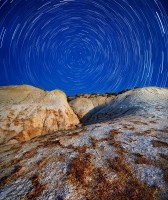Resistors and the Color Codes
Although the color code is not only for resistors, the ability to read the resistor color code is more required among engineers and scientists. This convenient index was created by Radio Manufactures Association (now part of Electronic Industries Alliance) in early 1920s. It is hard to tell some of colors and which side should indicates the tolerance. In fact, the tolerance of resistors in the 4th or 5th bands are sometimes distinguished by spacing or width of the band. This page provides how you read the 4th-, 5th-, and 6th-band resistor color codes, and the related information on resistors.
Go Back to Hiro's Physics Main
Contents
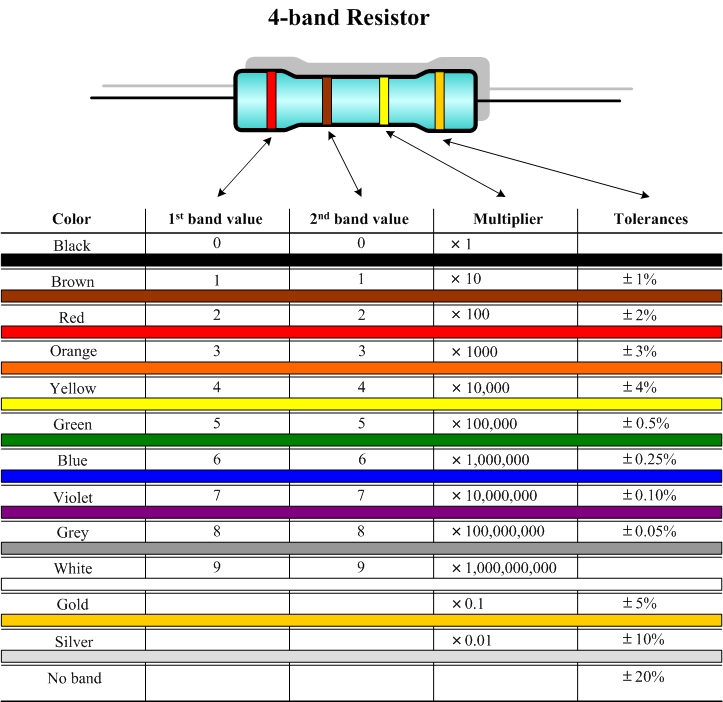
Example: (four bands)

Yellow, Green, Orange, Silver
Yellow and green represent 4 and 5, respectively. Those consist of the first and second digits, so it will be 45. The third band is orange. As a multiplier, it is × 1000, so you will calculate 45 × 1000; therefore, the resistance is 45,000 Ω. The forth band, silver, represents the tolerance, so the final expression of the resistance is 45,000 ± 10% Ω.
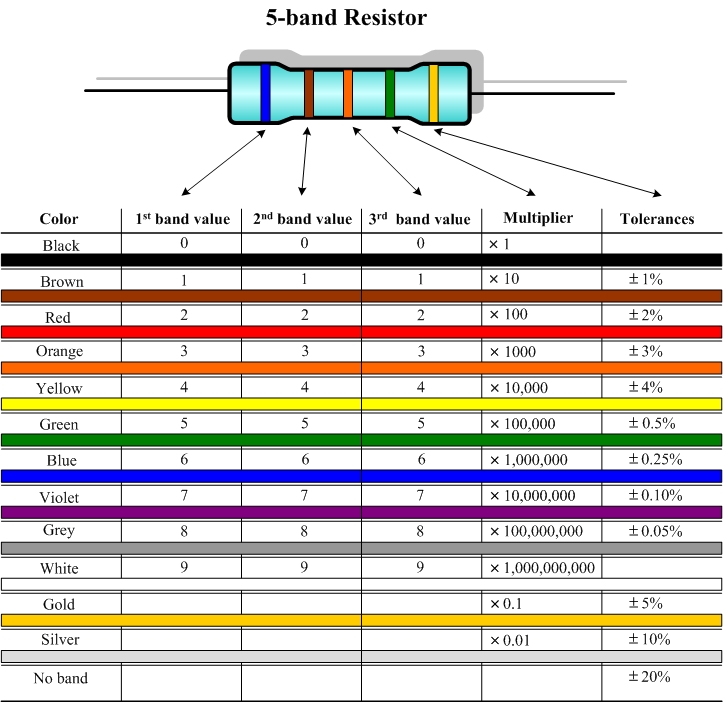
Example: (five bands)

Yellow, White, Yellow, Brown, Gold
Yellow, white and yellow represent 4, 9 and 4, respectively. Those consist of the first, second and third digits, so it will be 494. The forth band is brown. As a multiplier, it is × 10, so you will calculate 494 × 10; therefore, the resistance is 4,940 Ω. The fifth band, gold, represents the tolerance, so the final expression of the resistance is 4,940 ± 5% Ω.
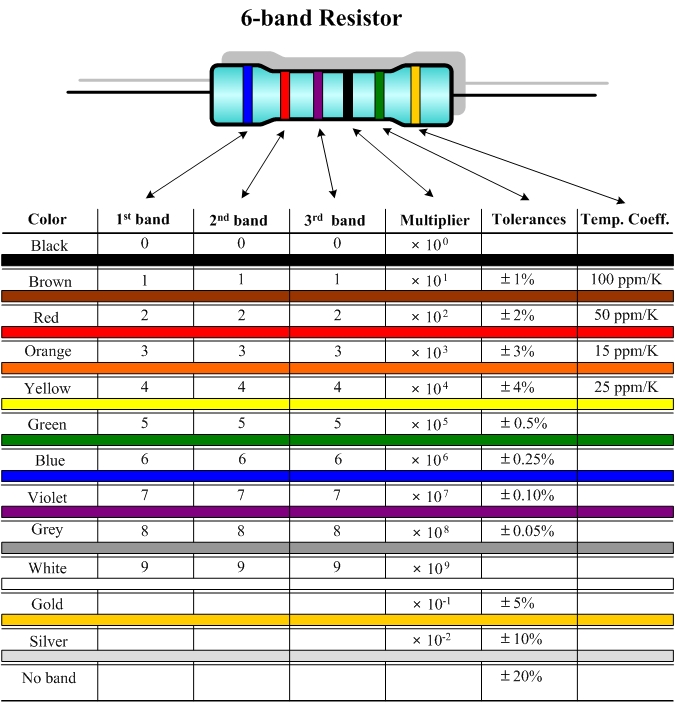
Example: (six bands)

Violet, Grey, Green, Red, Silver, Brown
Violet, grey and green represent 7, 8 and 5, respectively. Those consist of the first, second and third digits, so it will be 785. The forth band is red. As a multiplier, it is × 100, so you will calculate 785 × 100; therefore, the resistance is 78,500 Ω. The fifth band, silver, represents the tolerance, 10%. The sixth band is the temperature coefficient of the resistor. Brown represents 100ppm/K. Namely, the final expression of the resistance is 78,500 ± 10% Ω with Temp. Coeff. 100 ppm/K.
Each color corresponds to a certain number:
There are several mnemonics for this. Some of statements might not be politically correct.
Better Be Right Or Your Great Big Venture Goes West
Bad Beer Rots Our Young Guts, But Vodka Goes Well
Black Bears Run Over Yellow Grass, But Vultures Glide over Water
Big Bears Run Over Your Gladiola Bed Vexing Gliarden Worms
Black Bugs Race Over Yellow Grass, Beside Violent Grey Water
↑ Go to the top of this page
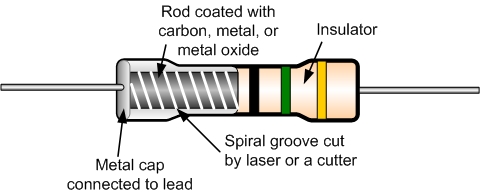

The independent resistor array contains each separated resistor. The bussed resistor array contains connected resistors with one common terminal as shown in the figure.

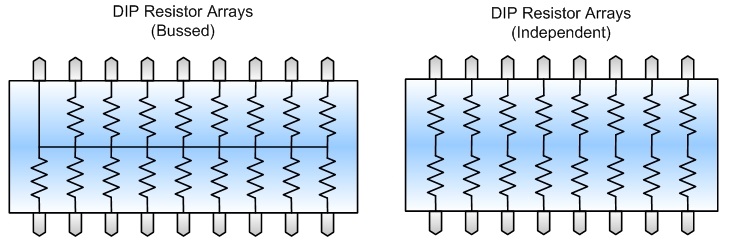
Contents
- Four-band resistor color codes
- Five-band resistor color codes
- Six-band resistor color codes
- Mnemonics
- Various resitors and the properties
Four-band resistor color codes
(PDF file for 4-band color codes)

Yellow, Green, Orange, Silver
Yellow and green represent 4 and 5, respectively. Those consist of the first and second digits, so it will be 45. The third band is orange. As a multiplier, it is × 1000, so you will calculate 45 × 1000; therefore, the resistance is 45,000 Ω. The forth band, silver, represents the tolerance, so the final expression of the resistance is 45,000 ± 10% Ω.
Five-band resistor color codes
(PDF file for 5-band color codes)

Yellow, White, Yellow, Brown, Gold
Yellow, white and yellow represent 4, 9 and 4, respectively. Those consist of the first, second and third digits, so it will be 494. The forth band is brown. As a multiplier, it is × 10, so you will calculate 494 × 10; therefore, the resistance is 4,940 Ω. The fifth band, gold, represents the tolerance, so the final expression of the resistance is 4,940 ± 5% Ω.
Six-band resistor color codes
(PDF file for 6-band color codes)

Violet, Grey, Green, Red, Silver, Brown
Violet, grey and green represent 7, 8 and 5, respectively. Those consist of the first, second and third digits, so it will be 785. The forth band is red. As a multiplier, it is × 100, so you will calculate 785 × 100; therefore, the resistance is 78,500 Ω. The fifth band, silver, represents the tolerance, 10%. The sixth band is the temperature coefficient of the resistor. Brown represents 100ppm/K. Namely, the final expression of the resistance is 78,500 ± 10% Ω with Temp. Coeff. 100 ppm/K.
Mnemonics
Each color corresponds to a certain number:
| Black | Brown | Red | Orange | Yellow | Green | Blue | Violet | Grey | White |
| 0 | 1 | 2 | 3 | 4 | 5 | 6 | 7 | 8 | 9 |
↑ Go to the top of this page
Various resistors and the properties
There are many types of resistors for various uses.Film type resistors
These resistors are made from small rods of ceramic coated with resistive materials. The rough value of resistance is determined by the shape of the core material; then, a thin spiral groove cut by a laser or diamond cutter on the surface adjusts the fine value of resistance. It is attached to metal caps with leads, and coated with an insulated layer to be completed as a retailing resistor.
Carbon film resistors
Metal film resistors
Metal oxide film resistors
 The core rod of the resistors is coated with carbon. These resistors are commonly used and the purchased inexpensively.
The core rod of the resistors is coated with carbon. These resistors are commonly used and the purchased inexpensively.
 The core rod of the resistors is deposited with metal such as nickel alloy. The temperature coefficients are very small, and
they are used for highly accurate circuits.
The core rod of the resistors is deposited with metal such as nickel alloy. The temperature coefficients are very small, and
they are used for highly accurate circuits.
 The core rod of the resistors is deposited with metal oxide, such as tin oxide. These resistors can handle more electricity than other
film resistors.
The core rod of the resistors is deposited with metal oxide, such as tin oxide. These resistors can handle more electricity than other
film resistors.
Wirewound type resistors
The resistors are made with a ceramic or glass rod, an insulator and resistive wire, such as the alloy of Nickel and Chromium (Nichrome) or the alloy of Copper, Nickel, and Manganese (Manganin). The value of resistance is adjusted by the amount of the wire wound around the ceramic or glass rod. The values of resistance are normally small and they are easy to be heated; however, they can deal with large amounts of electricity due to heat-resistant holders.
Cement resistors
Metal clad resistors
These resistors are housed in a thick alminum case to prevent from damage, humidity, pressure, and heat.
They are also great at short-time overload.
 These resistors are made with resistive wire or metal oxide film covered by silicon resin (cement),
which is inflammable even though it becomes very hot.
These resistors are made with resistive wire or metal oxide film covered by silicon resin (cement),
which is inflammable even though it becomes very hot.
Multiple type resistors
The resistor contains multiple resistors with multiple leads. It is convenient to use it when multiple resistors have to be connected to multiple terminals in a limited room on a bread board.The independent resistor array contains each separated resistor. The bussed resistor array contains connected resistors with one common terminal as shown in the figure.


Resistor arrays (networks) [SIP type]
Resistor arrays (networks) [DIP type]

 SIP stands for Single Inline Package. An example is shown in a photograph.
SIP stands for Single Inline Package. An example is shown in a photograph.
 DIP stands for Double Inline Package. An example is shown in a photograph.
DIP stands for Double Inline Package. An example is shown in a photograph.
Other types of resistors
Chip resistors
Variable resistors
Audio resistors
 These are made by surface mount technology, and they are sometimes called SMF resistors.
The size is very small. It is about 1-mm wide (0.04 inches).
These are made by surface mount technology, and they are sometimes called SMF resistors.
The size is very small. It is about 1-mm wide (0.04 inches).
 These resistors can adjust the value of resistance continuously within the specified range.
These resistors can adjust the value of resistance continuously within the specified range.
 This resistor is made especially for high-end audio amplifiers. The basic structure is similar to a film resistor, but
the materials used are magnet free to minimize disturbance of audio properties. This is also great at heat dissipation.
This resistor is made especially for high-end audio amplifiers. The basic structure is similar to a film resistor, but
the materials used are magnet free to minimize disturbance of audio properties. This is also great at heat dissipation.
